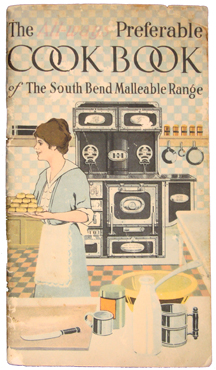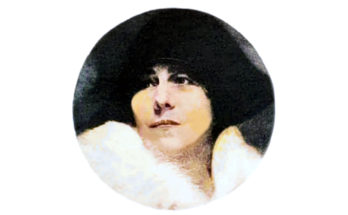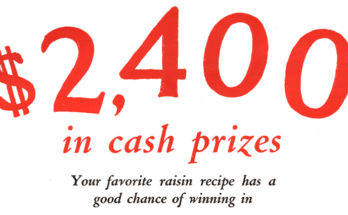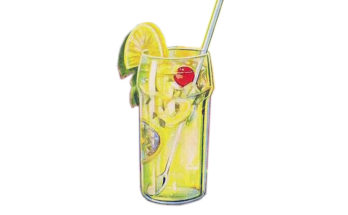c. 1924: The All-Ways Preferable Cook Book of The South Bend Malleable Range, Select Cooking Recipes, compiled by Miss Ada A. Hillier, Instructor of Domestic Science, South Bend Public Schools.
…It use to be thought clever for a girl to say: “I don’t know a thing about cooking.” But this is no longer the case. Now the women, young and old, are proud to say: “I can cook a good meal, one you will really enjoy.”
…What is true Kitchen Economy? To put it in as few words as possible, it is this: Provide the Purest and Best Materials and Cook Them Properly.
…If you have anything unpleasant to tell, never mention it at meal time….
Stuffing for Fish
1 cup cracker crumbs
1/4 teaspoonful salt
1/4 teaspoonful pepper
1 teaspoonful chopped onion
1 teaspoonful chopped parsley
1 teaspoonful chopped capers
1 teaspoonful chopped pickles
1/4 cup melted butter
Toss the crumbs in the melted butter, add the other seasonings. This makes a dry, crumbly stuffing.
Scalloped Meat, No. 2
Cut cold meat into small pieces, season to taste, and moisten with gravy. Make in layers with bread crumbs and bake twenty to thirty minutes in a hot oven, or until the crumbs are brown.
Buckwheat Cakes
1 cup white flour
1 1/2 cups buckwheat flour
1/2 teaspoonful salt
1 pint lukewarm water
1/4 cake of yeast, dissolved in a little lukewarm water
Mix all the ingredients together and beat thoroughly. Let rise over night in a warm place. In the morning add one-fourth teaspoonful soda and one tablespoonful sugar. One tablespoonful of butter added to the mixture will prevent the cakes from sticking, without the use of fat on the griddle, if the griddle is just the right temperature.
Bread
In all mixtures in which yeast is used to leaven, bread flour should be used. Wheat and rye are the only two grains that contain gluten of a good quality and of sufficient quantity to make a good loaf of bread. This gluten when separated from the rest of the flour is a grayish yellow, tenacious, elastic mass, and it is the elasticity which makes it so valuable in bread making, for as the gas is formed during the process of fermentation, it stretches, thus holding the gas in.
The best bread is made from the white wheat flour, and the best bread flour is made from the spring wheat, for it contains more gluten than does the winter wheat.
A good bread flour is granular and easily slips through the sieve, while the pastry flour is more solid. It also is of a creamy color.
Liquid, dry or compressed yeast may be used in bread making. The latter makes excellent bread when it can be obtained perfectly fresh. The yeast plant is killed when heated to 212 degrees F.; life is suspended but not utterly destroyed at 32 degrees F. The best temperature for its growth is from 75 to 80 degrees.
Yeast is a microscopic plant of fungus growth which multiplies very rapidly under favorable conditions, and by this process of growing causes a chemical change called fermentation.
Alcoholic fermentation is that which is produced in substances rich in sugar and starch. Under the influence of warmth and moisture and some ferment (yeast), the starch is converted into sugar and the sugar into alcohol and carbonic acid gas. This is the fermentation that takes place in bread making; the carbonic acid gas seeking to escape lightens the dough. If alcoholic fermentation goes beyond a certain limit, acetic fermentation takes place, in which the alcohol formed is turned into acetic acid and the mixture is sour.
Bread is made by mixing to a dough flour with a definite quantity of milk or water, salt and ferment. Enough sugar should be added to restore the natural sugar of the wheat changed during fermentation. the dough is then kneaded to thoroughly incorporate the ingredients, and is allowed to rise till double in bulk. It is then kneaded a second time to break the large bubbles of gas formed.
It is shaped into loaves and allowed to rise again. If it rise too long, it will be coarse grained; if not long enough, it will be heavy.
Bread is baked (1) to kill the ferment, (2) to make the starch soluble, (3) to drive off the alcoholic and carbonic acid gas, (4) to form a brown crust of pleasant flavor.
The Baking of Bread
…The heat should increase slightly for the first ten minutes, and gradually decrease till the end of the baking. The heat in the center of the loaf should reach 212 degrees, otherwise the starch grains will not be ruptured or the yeast plants killed. The heat changes the starch on the exterior of the loaf to dextrin. When the loaf is removed from the oven, place it where the air will circulate freely around it. Do not cover, if you like a crisp crust. When cold, put it into a clean bread box, without any wrapping, as the latter will give it a musty flavor. The pan for baking bread should not be over four inches wide, four inches deep, and suited in length to the oven. When the loaf is larger than this, there is danger of the temperature in the center of the loaf not reaching 212 degrees F., and the yeast not being killed.
Raw Potato Yeast
One-fourth cupful of flour, one-fourth cupful of sugar, one tablespoonful of salt, three raw potatoes, one to two quarts of boiling water, one cupful or one cake compressed yeast. Pare potatoes and keep in cold water, mix flour, sugar and salt in a large bowl, and grate the potatoes in as quickly as possible, mix at once with a wooden spoon, pour the boiling water directly from the teakettle over them, stirring constantly, and adding enough water to make it consistency of thin starch; if it does not thicken, bring the mixture to the boiling point, strain, and let cool; when lukewarm add yeast; if compressed, dissolve in one cupful of water; keep mixture in warm (not hot) place till light, beat well several times at the end of twenty-four hours, put in earthen or glass jars, cover tightly and put in a cool place. This will keep two weeks.
If liquid yeast is used, allow one-half cup to one pint of liquid.
96-page booklet, Publisher: Malleable Steel Range Mfg. Co.



